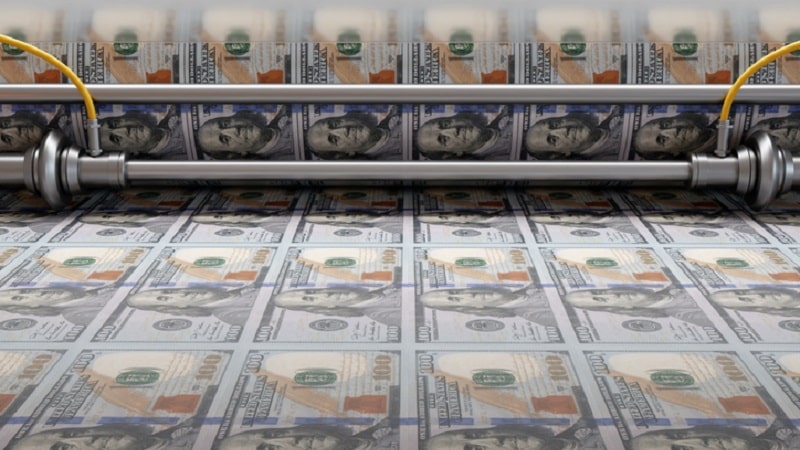US tariffs are expected to weaken the dollar as GDP growth slows


Changes in US trade policy are having a significant impact on the country’s currency, according to Goldman Sachs Research.
The increase in trade tensions and other uncertainty-raising policies are eroding consumer and business confidence, Goldman Sachs Research senior currency strategist Michael Cahill writes in the team’s report. The team finds that changing perceptions of US governance and institutions are also affecting the appeal of US assets for foreign investors, and the rapid back-and-forth on policy decisions makes it difficult for investors to price outcomes other than high uncertainty.
The US dollar’s weakness against its major peers during the first quarter of 2025 is anticipated by Goldman Sachs Research to persist. Over the next 12 months, the US currency is forecast to fall about 10% versus the euro, and around 9% against the Japanese yen and British pound (as of April 8).
For almost a decade, the currency has benefitted from flows into US assets from developed market economies such as the euro area, Japan, and Norway. A combination of factors including unattractive yields in other assets and dollar-asset outperformance have driven a substantial increase in the US currency’s share of global portfolios. That positioning is now expected to reverse.
“We have previously argued that the US’s exceptional return prospects are responsible for the dollar’s strong valuation,” Cahill writes. “But, if tariffs weigh on US firms’ profit margins and US consumers' real incomes, they can erode that exceptionalism and, in turn, crack the central pillar of the strong dollar.”
Will tariffs weaken the dollar?
Our strategists previously expected trade-related uncertainty to weigh more on foreign countries than on the US. But soft data in the US has, so far, shown worrying signs while European sentiment has been surprisingly resilient. This is partly related to non-tariff issues like federal spending cuts and concerns of a weakening labor market. But tariff policy is also part of the uncertain policy mix, which is contributing to the shakier US economic outlook.
There are signs that tariff announcements and a more aggressive stance toward historical allies are changing global views of the US and US assets. For example, consumer boycotts of US goods and reduced tourism flowing to the US (foreign arrivals to major US airports have fallen following recent tariff announcements) are weighing modestly on GDP expansion, according to Goldman Sachs Research.
“The combination of much stronger-than-expected foreign spending plans and weaker US asset performance has already led to some brief but active rotation out of US assets and increased interest in hedging US assets,” Cahill writes.
Foreign officials have taken a number of actions to attempt to reduce their reliance on the dollar. This is one of several reasons that the US currency’s share of foreign exchange reserves has steadily declined over the last decade and now sits close to its lowest level since the advent of the euro. “Up to now, private sector investors have more than compensated for reduced official sector demand, likely lured by superior asset returns,” Cahill writes. “It is possible that the broader policy disruptions and eroded exceptionalism will see private sector investors follow a similar pattern now.”
Who will pay the US tariffs on imports?
At the same time, the shifting nature of US tariffs is likely to change how tariffs impact the economy, according to Goldman Sachs Research. Tariffs can be paid through some combination of lower margins at foreign firms, lower domestic margins, or higher domestic consumer prices. Typically, academic literature finds tariffs are paid via some mix between these three channels. But, if domestic firms have less negotiating power, then the pass-through will be smaller.
In the case of tariffs on so-called critical imports, which are hard to substitute, increased foreign pricing power means that US terms of trade may need to adjust via higher import costs. That means the dollar should depreciate, rather than the foreign currency.
“With broad and unilateral tariffs now on the table, there is less incentive for foreign producers to provide any accommodation,” Cahill writes. “US businesses and consumers become the price-takers, and it is the dollar that needs to weaken to adjust if supply chains and/or consumers are relatively inelastic in the short term.”
Put another way, the US raising tariffs across the board changes the dynamic for foreign exchange. Typically, the pricing power of the larger or dominant country leads foreign firms to "pay" some portion of the tariff. But, with the cost of foreign production rising everywhere, it’s possible the US will have to bear more of the cost of the tariffs. In this outcome, US terms of trade would deteriorate and the dollar would depreciate.
“This is far from guaranteed, but it is newly possible with a 10% across-the-board tariff affecting every country outside the US,” Cahill writes. The dynamics at play in the latest trade tensions at least open new possibilities relative to Trump’s first administration, when there was potentially room for US companies to source goods from outside China and avoid the tariffs.
This article is being provided for educational purposes only. The information contained in this article does not constitute a recommendation from any Goldman Sachs entity to the recipient, and Goldman Sachs is not providing any financial, economic, legal, investment, accounting, or tax advice through this article or to its recipient. Neither Goldman Sachs nor any of its affiliates makes any representation or warranty, express or implied, as to the accuracy or completeness of the statements or any information contained in this article and any liability therefore (including in respect of direct, indirect, or consequential loss or damage) is expressly disclaimed.
Our signature newsletter with insights and analysis from across the firm
By submitting this information, you agree that the information you are providing is subject to Goldman Sachs’ privacy policy and Terms of Use. You consent to receive our newletter via email.